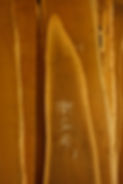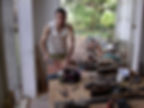

MY STORY
Wood and Ocean: the two things fascinated me ever since I was a child.
As a boy of 15, I built a small boat and did a lot of day -sailing along the coast.
As a young man at 30, I had a bigger sailing boat; a 38 -foot wooden yacht named Tradewind which I soon took into the open waters on a 7- year adventure around the world. But early into that journey, in the Australian waters, a hurricane struck and my yacht capsized suffering severe damage.
The limited budget I was restricted to forced me to do the repairs myself – a job that would take a whole year.
But it became an opportunity of a lifetime.
For at the end of that period, I knew what I wanted to do for the rest of my life – to be a professional wood craftsman.
On my return to Japan I joined a wood workshop and began my apprenticeship as a carpenter. There I worked under several master craftsmen learning different skills from each one:
Yonamine sensei taught me how to pick and read the wood;
Oyadomari sensei demanded exacting standards and precision work where the error margin had to fall within 1/1000 of the dimensions;
From Yuikikaku sensei I learnt how to measure, plan, and make accurate sketches and then execute the designs;
and finally Shiroma sensei taught me how to reveal the hidden beauty of the wood and enhance its unique individuality.
It was in the year 2001 that I moved to Auroville in Tamil Nadu in South India where I established my own workshop – ‘Kenji’s Woodwork’.

THE WORKSHOP
‘Kenji’s workshop’ is located in South India - Tamil Nadu – Auroville – Kottakarai, a quiet community surrounded by dense green foliage, mango trees and frequented by peacocks.
The workshop is a 140m2 brick building where over half the space is used as a storage area for the wood that is being seasoned.
The team consists of one worker, an apprentice, and me. This work demands much concentration. Therefore besides some technical discussion, we share few words.
I care very much for every single piece of furniture; each piece is unique and requires attention to smallest detail. This is the reason why the workshop produces only a limited number of pieces.

MY APPROACH TO WOOD
I usually buy the wood as a log. When possible, I like to go along with a woodcutter into the forest. I have the log cut into the right size and bring it to my workshop. There it is allowed to rest and age for a full year (at least).
Little by little, the plank heaves, moves, bends, shrinks, and cracks, until it finally calms down. At this stage this ‘bent-cracked-shrunk’ plank that has undergone all its possible distortions is ready to be cut. To keep wood in the workshop without using it for a year or more, costs money and demands patience. But this is an essential step as the prolonged seasoning ensures that the furniture that is created does not start to warp or bend again.
The next step is to ‘plane’ the plank which means to make the surface flat. If the plank is wider than 40 cm, the work has to be done by hand as the machine cannot handle the job.
It is after this process that the moment finally arrives when I can meet the face of the tree. It is at this moment, that ‘we’ - the wood and myself - decide what the wood wants to become…

MY CREATION
I specialize in Japanese style furniture – both traditional and contemporary. My designs follow two types of expression: one that is linear and straight, following the geometry of the essential line; and the other, flowing with the organic form of the tree, keeping to the free edge and the uneven movement. In either case, the top surface is finished to a perfect flatness that is both smooth and burnished.
What I love making is furniture that has a warm and mysterious feel to it… furniture that has a ‘personality’ of its own… something that can become a part of the home and a living presence… Whatever is made is done in accordance with the nature of the wood, its shape, and grain pattern.
Personally what I enjoy most to make is the table, especially the low table characteristic of Japan. I also do cupboards, cabinets, bedside tables, sofas, room dividers, decorative boxes, ‘mouse-pads’, and also more free-form sculptural pieces that can be displayed on the wall.
I am also open to working together with customers on special requests for a one-of-a-kind designs, or to work with special woods that one may want something to be created from.
Besides Auroville, my furniture has found a place in homes and hotels in India, Japan, Germany, France, USA and Italy.




TYPE OF TIMBER
In Japan, I used a soft type of wood, a type of cypress called ‘hinoki’. This is an evergreen or coniferous tree with needle-like leaves.
In India, I have to use the more hardy deciduous tree varieties whose wood is generally hard and more difficult to work with. But the wood grain pattern of these sub-tropical and tropical trees is very beautiful. Occasionally or under special request, I have also worked with teak, rosewood and sandal, the latter being one of the most famous and expensive woods in the world.
More often I use Acacia, Tree jasmine (Millingtonia hortensis), Jack fruit (Artocarpus heterophyllus), Vengai (Pterocarpus marsupium), Karimarudu (Lagerstroemia lanceolata), and Noona maram (Morinda citrifolia).
Acacia: Local name is ‘pencil’ maram. It is a very popular wood for furniture and construction. The colour varies from light to dark brown. It is a heavy type of wood, but easy to work with. The grains often show beautiful patterns. After a fine polish, the surface gets smooth as silk.
Tree Jasmine: The local name is poomaram or ‘flower’ tree since it bears beautiful white flowers. The colour of the wood is creamy white; and the grainage is graceful and delicate.
Vengai: Since it is a very strong and straight-growing tree, it was often used in construction to make both pillars and beams. Unfortunately unsustainable logging has resulted in the complete disappearance of this tree from Tamil Nadu. However, the wood can still be procured from abroad. The colour is a dark burnt brown; and the wood is of high density with conspicuous pores. The grain patterns are unclear and indefinite.
Karimarudu: This is an all-purpose wood that has also disappeared completely from Tamil Nadu. One can get this wood only from the beams and pillars salvaged from old houses that are being dismantled. Its colour ranges from a dark brown to a dark violet-brown.
Noonamaram: In general, the wood of all trees show an outer area that is of a lighter shade than the inner heartwood which is generally darker in colour. This is not so in the case of the Noonamaram which has a central pale area (almost greyish-pink), surrounded by a darker (brown) periphery. This wood is made up of very hard fibres which make it difficult to smoothen by sand paper. Despite the difficulty, the grain is very interesting which makes the wood most suitable for unique creations.

OTHER MATERIALS
There have been times when I have come across a piece of wood that upon cutting reveals stones or other foreign bodies incorporated into it. These have sometimes been very beautiful and mysterious. Inspired by this rare but natural occurrence, I have started to experiment with both polished stone as well as precious metals.
In cases, where the wood has knots or interesting gaps and openings in its body, I have incorporated granite or semi-precious stone (malachite, agate etc.) into these spaces.
I have also experimented with inlay work using 24-carat gold foil. This I have found to be particularly suitable where the wood has natural peculiarities like depressions, or local concavities that can be highlighted to the advantage of the furniture. The gold foil is painstakingly applied by tweezers and moulded to the wood surface using resinous gum, and later protected by several layers of polyurethane spray.
The interaction between wood and these natural elements of metal and stone becomes a natural play, and evokes another kind of contemplation in the viewer.



HAND TOOLS
& MACHINES
In order to establish my workshop in Auroville, I had several heavy duty professional industrial machines (Level Planer, Thickness Planer, and an Adjustable circular saw) transported from Japan through containers. If I had bought these machines in India I would have saved myself a lot of expense and energy, but as Japanese toolmanship is very precise and superior, the investment I felt would be well worth the effort.
Even though my work demands a lot of hand finishing, the precise cutting of wood to make my base planks with these machines makes a noticeable difference.
In the same way, hand tools to a carpenter are very important; they need to be always kept in the best condition – extremely sharp and well-cared for. While I let my worker and apprentice use the Japanese tools in the workshop, I also teach them the importance of maintenance.




The shape of my furniture is not very elaborate.
However I care about volume and dimension, a quality that I often find missing in Tamil furniture that is characterized by a ‘planar flatness’.
I look for quiet harmony in a simple form.
As a technique of construction, I use Japanese traditional joinery (ki-gumi), avoiding as far as possible the use of metal inserts such as nails, screws or bolts. I even upgraded it to a unique technique that prolongs the life of the furniture.
Depending on its intended use, I protect the furniture with several coats of linseed oil or polyurethane resin.
DESIGN &
EXECUTION

VIDEOS
Kenji can be watched from 2:11
Kenji can be watched from 1:52
PUBLICATIONS



























